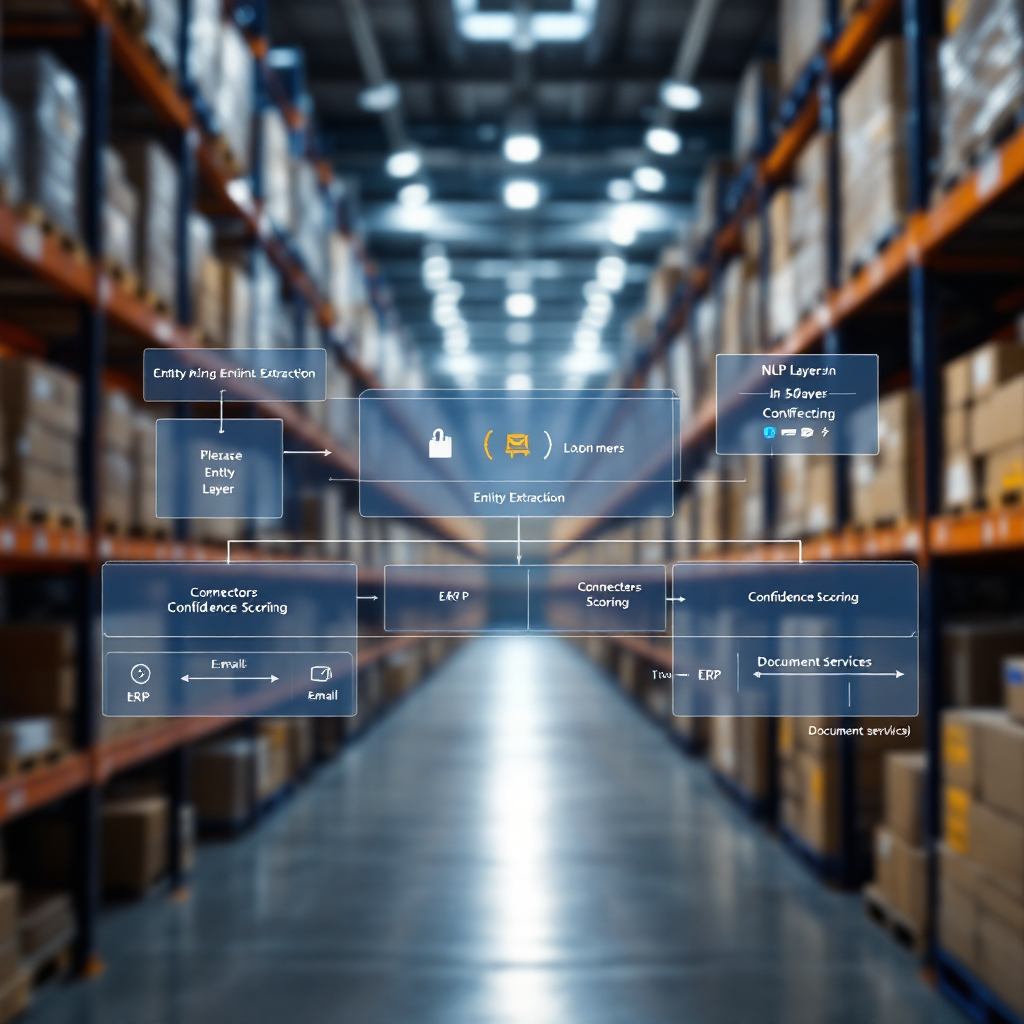ai and erp: why ai email agents change enterprise resource planning
AI is reshaping how enterprise resource planning teams handle email. An AI email agent sits between shared mailboxes and ERP modules. It reads inbound messages, extracts structured fields, and then updates finance, procurement, or CRM records. These specialized agents for ERP can reduce repetitive work and speed approvals. For boards and IT sponsors the story is simple: measurable ROI and faster throughput. Oracle reports productivity gains of up to 30% when AI agents handle administrative tasks (Oracle: Agentes de IA). SAP finds roughly 40% better data accuracy when agents scan unstructured sources like emails and PDFs (Análise SAP). Dataforest estimates a 25% uplift in forecasting and inventory optimization from AI-driven automation in ERP (Dataforest). Such metrics make a compelling operational case. Typical inbound use cases include invoice capture, order confirmations, supplier updates, and customer queries that directly update ERP modules. An AI agent that recognizes an invoice can parse the amount, match it to a purchase order, and flag exceptions. A virtual assistant then drafts the reply using context from the ERP, email history, and attached documents. For logistics teams, pairing AI with ERP reduces the repeated copy‑paste that wastes time; our experience shows handling time drops from ~4.5 minutes to ~1.5 minutes per email when AI is properly connected. If your board asks for top-line impact, present productivity gains, data‑accuracy improvements, and the expected reduction in operating cost. For practical rollout guidance and logistics-specific scenarios see our guide to automating logistics email drafting with AI (redação de e-mails logísticos com IA). This chapter sets the expectation: AI email agents improve throughput, reduce errors, and deliver ROI for enterprise resource planning and teams that field high volumes of customer emails.
ai email and inbox automation: routing, email history and faster responses
AI systems process the inbox in predictable stages. First an AI agent classifies messages by intent and priority. Then it extracts entities like invoice numbers, SKUs, and ETAs. Next it routes the message to the right ERP module or human queue. This routing pattern often uses a rule + ML hybrid. The hybrid mixes deterministic rules with learned classifiers and confidence thresholds. If the confidence score is low the message falls back to a human queue. This approach reduces risk and helps teams trust the outputs. Email history provides immutable logs and context across threads. When an agent integrates with ERP it can ground replies in ERP records and show the exact data elements used. That makes audits simpler. Many teams keep an email history that links each message to the corresponding order or invoice. An AI email assistant can auto-populate ERP fields from the thread and save time during onboarding. For shared mailboxes, agents behave thread-aware and preserve consistent tone. Practical metrics matter: these patterns reduce manual triage and lower missed SLAs. Companies report faster first response times and fewer escalations when agents operate with clear fallback rules. Our no-code platform wires email addresses to data connectors so agents operate without heavy IT work. If you want a logistics example, read about automating logistics correspondence and how draft generation improves turnaround (correspondência logística automatizada). Use confidence thresholds to control agentic AI actions and keep human review when needed. Finally, add monitoring so the team can spot declines in accuracy and tune the classifier. That preserves service levels while delivering measurable speed improvements for customer experience and operations.

Drowning in emails? Here’s your way out
Save hours every day as AI Agents draft emails directly in Outlook or Gmail, giving your team more time to focus on high-value work.
ai agent and assistant in erp system integration: agents for erp and erp platforms
Integration is where the ROI becomes real. An erp ai agent must connect to ERP platforms like SAP, Oracle, and Microsoft Dynamics. Integration options include direct APIs, middleware or iPaaS, and event buses. For legacy ERP software RPA and secure inbox connectors bridge gaps. The technical goal is consistent data mapping, master‑data checks, and reliable transaction reconciliation. Agents integrate with order tables, vendor ledgers, and CRM records so that every email can update the correct place. Maintain idempotency and clear rollback paths. If an agent replays an action twice, the system must avoid duplicate receipts or payments. Data mapping often requires a small data contract and a canonical schema. Our work emphasizes an SQL-accessible layer so teams can audit and query the fused data sources. When you deploy agents into ERP, use event-driven patterns to keep systems synchronized in near real-time. For example an invoice parsed from a new email can emit an event that updates the accounts payable module and triggers a three‑way match. Use master data checks to avoid posting errors, and add reconciliation jobs that run overnight. For practical deployment tips, consult our resource on scaling logistics operations with AI agents (como dimensionar operações logísticas com agentes de IA). Integration work also requires governance. Grant role-based access to connectors, log every action, and keep a clear approval flow for high-risk transactions. That ensures the erp agent adds value without undermining transactional integrity.
ai email agent and ai email assistant: ai-powered, agentic ai and generative ai capabilities
Modern AI capabilities include natural language processing, named entity recognition, classification, intent detection, and generative AI for drafts. An AI email agent uses these ai capabilities to read email content and either suggest a reply or take action. Distinguish the ai assistant from the agent. An AI assistant offers draft replies and suggestions. An AI agent acts agentically and can autonomously update ERP records or send replies when confidence is high. Start in assistive mode to measure accuracy. Then enable agentic AI gradually. Safety controls are vital. Use human‑in‑the‑loop gating, action logs, and undo workflows. Keep a decision log that records model version, confidence, and the ERP records touched. For draft generation, ground replies in ERP data so the ai-powered email output cites exact order IDs and shipment ETAs. That reduces hallucination risk. When enabling agentic ai, define escalation policies for exceptions. For example, agents can auto-approve status updates under a threshold, while complex disputes require human approval. This approach lets teams focus on high-value exceptions while agents handle repetitive tasks like invoice acknowledgment and ETA updates. Our platform provides no-code control so business users set templates, tone, and escalation paths without prompt engineering. Use metrics to decide when to switch modes: measure automation rate, error rate, and user trust. Implement a phased rollout: assist → validate → automate. Train models with company data and provide training on preferred phrasing and SOPs. That ensures agents behave consistently and improve customer experience while keeping humans in control.

Drowning in emails? Here’s your way out
Save hours every day as AI Agents draft emails directly in Outlook or Gmail, giving your team more time to focus on high-value work.
compliance and best practices: email assistant, GDPR, secure automate and audit trails
Compliance is non-negotiable when agents monitor and modify business data. Build a checklist that includes personal‑data detection, data minimisation, lawful basis, retention, and encryption in transit and at rest. Add privacy policy alignment and consent records where required. Keep full audit and traceability: complete email history, decision logs, and model versioning. Regulators expect the same rigor as for other ERP transactions. Implement role-based access, per-mailbox guardrails, and redaction for sensitive fields. Best practices demand periodic model reviews and red-team testing on privacy and safety scenarios. Create SOPs that define when agents can act autonomously and when human approval is mandatory. For financial workflows such as invoice processing, document the approval chain and retention policy. Use explainable models or add explainability layers so auditors can see why an AI suggestion was made. Apply the same governance to agent workflows as you do to procurement and accounting. For legal teams, provide a record linking email content to ERP entries and show how the agent integrates into the change control process. This ensures the organization can answer auditors and regulators about data sources and decisions. Finally, maintain an escalation path for any suspected misuse and schedule regular reviews of the privacy policy and role-based access controls. These steps let you enable erp systems to benefit from AI while meeting compliance requirements and preserving trust.
optimize productivity: erp ai agent, ai-powered erp, best ai tools to optimize workflow
To optimize productivity you need clear KPIs and a practical roadmap. Track automation rate, error rate, mean time to resolution, cost per case, and user satisfaction. Focus on high-value workflows first, then scale. A recommended roadmap is: pilot → measure → extend workflows → scale across ERP modules. Keep sprints short, six to eight weeks, and define acceptance criteria for accuracy and SLA gains. Choose ai tools that support explainability, confidence thresholds, and easy rollback. Consider commercial AI-powered ERP features and third-party agents. For logistics teams, our comparisons of tools explain trade-offs and help pick connectors and models (melhores ferramentas de IA para empresas de logística). Use continuous monitoring and a feedback loop so models learn from corrections. Instrument analytics to measure uplift in productivity and predictive analytics performance. If predictive analytics improve inventory forecasts, quantify stocking improvements and tie them to cost reductions. Provide training and onboarding for users so they trust agent outputs. Also document agent development standards and testing procedures. Deploy agents across mailboxes, but keep per-mailbox guardrails and escalation rules. Finally, ensure you have production monitoring and a governance loop that updates templates, training data, and SOPs. With these practices you can reduce manual triage, improve customer satisfaction, and sustain the productivity gains that AI adds to enterprise resource planning systems.
FAQ
What is an AI email agent and how does it work?
An AI email agent reads and classifies emails, extracts relevant fields, and takes actions like updating ERP records or drafting replies. It uses natural language processing, entity extraction, and confidence scoring to decide whether to suggest a response or automate a task.
How do AI email agents improve invoice processing?
Agents scan invoices, extract amounts and PO numbers, and match them to purchase orders in the ERP. This automation reduces manual data entry and cuts processing time while improving accuracy.
Are AI email agents safe for financial workflows?
Yes, when you implement role-based access, audit logs, and human‑in‑the‑loop gating. Define clear approval paths and rollback procedures for sensitive transactions to preserve transactional integrity.
What integration options exist for connecting agents to ERP platforms?
Integrations include direct APIs, middleware/iPaaS, event buses, and RPA for legacy modules. Choose the option that minimizes risk and preserves master‑data accuracy during synchronization.
How do I measure the success of an AI email agent pilot?
Track automation rate, error rate, mean time to resolution, cost per case, and user satisfaction. Use these KPIs to decide when to move from assistive to agentic modes.
Can AI agents draft replies while ensuring brand tone?
Yes, templates and tone controls let you configure stylistic rules. Business users can set tone and templates without prompt engineering in many no-code platforms.
What compliance safeguards are needed for email automation?
Ensure personal‑data detection, minimisation, lawful basis, retention policies, and encryption. Maintain full audit trails and model versioning for regulatory review.
How do agents handle ambiguous or low-confidence emails?
Set confidence thresholds so low-confidence items route to human queues. This hybrid approach prevents costly mistakes and builds trust in automation.
How long does it take to deploy agents across a team?
Pilot deployments take a few weeks for API connections and configuration. Scaling across teams typically follows a measured sprint plan of several months with iterative improvements.
Where can I learn more about AI for logistics and ERP email automation?
Explore resources on automating logistics correspondence, virtual assistant workflows for logistics, and how to scale operations with AI agents on our site. These guides cover practical use cases and tool comparisons for logistics teams.
Ready to revolutionize your workplace?
Achieve more with your existing team with Virtual Workforce.